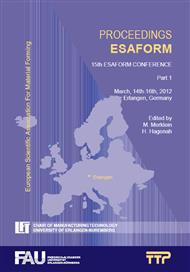p.125
p.131
p.137
p.143
p.151
p.157
p.163
p.169
p.175
EcoForge: Resource-Efficient Process Chains for High Performance Parts
Abstract:
Classical forging process chains for the production of high performance parts consist of heating, hot forming, machining and heat treatment stages. Especially the last stage comprises numerous energy consumptive heating and cooling procedures. Consolidation of these process chains has a large energy-saving potential and thus can lead to ecological and economic advantages. In addition, the optimization may result in well enhanced local material properties in the final part. Therefore, the collaborative research project “EcoForge: Resource-efficient process chains for high performance parts” has been initiated. Five renowned research institutes aim at optimising the industrially relevant process chain in order to facilitate the resource-efficient production of forgings with increased load bearing capacity. The six subprojects of EcoForge include both, numerical investigations on the microstructure evolution and cooling behaviour of the forged parts as well as numerous experiments which will be carried out in collaboration with the project’s industrial consulting committee, summarising up to 50 relevant participating companies. The joint project is funded by the AiF and BMWi aiming at major areas of technical developments in Germany.
Info:
Periodical:
Pages:
151-156
Citation:
Online since:
February 2012
Price:
Сopyright:
© 2012 Trans Tech Publications Ltd. All Rights Reserved
Share:
Citation:


